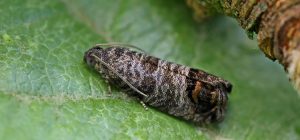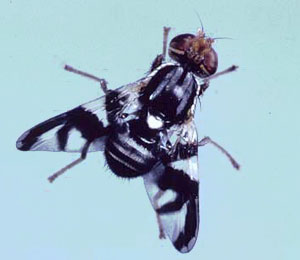Even though it is early May, people are starting to worry about the two main summer orchard pests in apples- codling moth and apple maggot. The past couple of summers have been warmer than average, and in warm summers, these two pests can destroy most peoples’ apple crops. What can you do to keep your apples from being ruined?
If you only have a couple of trees, the easiest control is to thin your young fruit now, and at the same time, apply ‘maggot barriers’ to the remaining fruit. These barriers are 90% effective in controlling codling moth, and 95% effective for apple maggot.
Though effective, this method of control is very time consuming if you have more than 2 or 3 trees. And it must be done early, before the codling moths start laying (and they are starting!) If your fruit has been damaged in the past couple of years, you may need to start spraying to control the pests. You can control both pests with organic sprays, but timing those sprays is critical.
 Timing Pest Sprays
Timing Pest Sprays
A little primer on heat units or Degree Days (DD): Most pests have certain temperature ranges when they are active. For codling moth, heat units accumulate when temperatures are between 50° and 88° Fahrenheit. For apple maggot, the models use 44° and 113° Fahrenheit. We look at accumulated degree days in the models to time the sprays.
Late May is usually the period we carefully watch heat units/DD to accurately time sprays for codling moth. Our warm spring has us ahead in heat units from the past years. Using the codling moth model, our degree day accumulation is 11 days ahead of 2015, 14 days ahead of 2014, and 37 days ahead of the 30 year average. Right now, it looks like we’ll reach the degree days to warrant a spray (525 DD) around the first week of June.
Using WSU’s No Biofix degree day model for Codling moth, the first expected egg laying should happen around 225 DD, which we hit in late April. The first recommended spray will go on at about 525 DD, which the models are predicting should be the first week of June. If May is very cool, we may not reach 525 DD until mid to late June. The most effective organic sprays for codling moth are Spinosad, and CM Granulosis Virus (CMGV). Spinosad is available to the homeowner in small quantities as Monterey Garden Spray and Green Light Bioinsecticide. For the larger grower, it can be purchased as Entrust. Adding 1% summer oil to the tank makes it even more effective by smothering eggs that have not hatched. Spinosad is toxic to bees when wet. Apply early in the morning or late in the evening when bees are not foraging! CM Granulosis Virus (CMGV) is only really available to the larger grower (large quantity, short shelf life) as Virosoft®, Caprovirusine® and Cyd-X®. Peaceful Valley Farm Supply sells small quantities online, but it is not registered for sale in Washington State in that packaging. CMGV must be applied at 525 DD, and again in 7-10 days. Unused product should be refrigerated. CMGV is not toxic to bees. It may have a delayed action, though, so if applied too late, the larvae may tunnel into the fruit before dying.

Apple Maggot
Spinosad is also somewhat effective on Apple Maggot. It would need to be sprayed every 10-14 days to provide good control. Right now, degree day models are showing first fly emergence in mid to late July. Putting up yellow sticky traps or red sphere traps coated with a sticky trap substance (Tanglefoot®) will trap adult flies as they emerge. If you have just a few trees, you may be able to trap most of the adult flies before they lay their eggs. If apple maggot has been a real problem in the past few years, you may need to spray when you find adult flies on your traps. The traps can also help you time sprays.
Another option is Surround, which is a kaolin clay product that coats the tree and developing fruit in a fine white dust that confuses the moths and sawflies (apple maggot flies) when they try to find fruit to lay eggs on. It must be reapplied after rain to keep the fruit coated and “hidden” from the insects trying to lay eggs. A negative aspect of Surround is that it usually is detrimental to beneficial mites, who spend more time cleaning the clay off their bodies than hunting pest mites.

